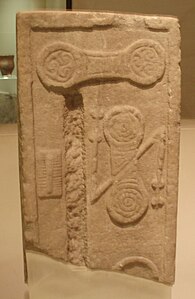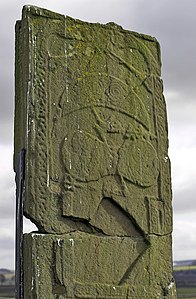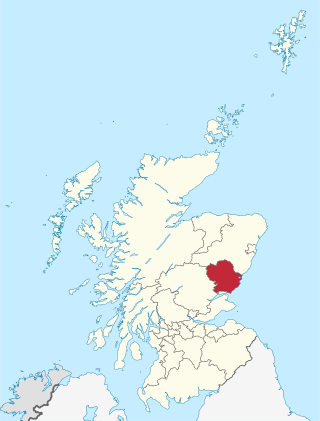
Angus is one of the 32 local government council areas of Scotland, a registration county and a lieutenancy area. The council area borders Aberdeenshire, Dundee City and Perth and Kinross. Main industries include agriculture and fishing. Global pharmaceuticals company GSK has a significant presence in Montrose in the north of the county.

A Pictish stone is a type of monumental stele, generally carved or incised with symbols or designs. A few have ogham inscriptions. Located in Scotland, mostly north of the Clyde-Forth line and on the Eastern side of the country, these stones are the most visible remaining evidence of the Picts and are thought to date from the 6th to 9th century, a period during which the Picts became Christianized. The earlier stones have no parallels from the rest of the British Isles, but the later forms are variations within a wider Insular tradition of monumental stones such as high crosses. About 350 objects classified as Pictish stones have survived, the earlier examples of which holding by far the greatest number of surviving examples of the mysterious symbols, which have long intrigued scholars.

Aberlemno is a parish and small village in the Scottish council area of Angus. It is noted for three large carved Pictish stones dating from the 7th and 8th centuries AD ; the stones can be viewed at any time in spring-autumn, but are covered by wooden boxes in the winter to prevent frost damage. Two stones stand by the B9134 Forfar-Brechin road, the Kirkyard Stone stands in the nearby graveyard of the parish church.

The Hilton of Cadboll Stone is a Class II Pictish stone discovered at Hilton of Cadboll, on the East coast of the Tarbat Peninsula in Easter Ross, Scotland. It is one of the most magnificent of all Pictish cross-slabs. On the seaward-facing side is a Christian cross, and on the landward facing side are secular depictions. The latter are carved below the Pictish symbols of crescent and v-rod and double disc and Z-rod: a hunting scene including a woman wearing a large penannular brooch riding side-saddle. Like other similar stones, it can be dated to about 800 AD.
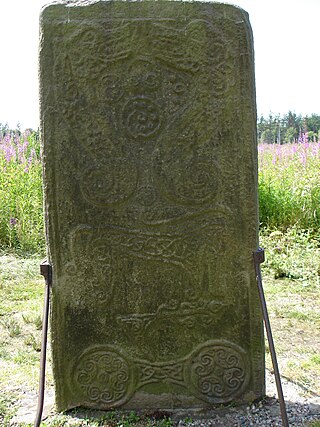
Rodney's Stone is a two-metre high Pictish cross slab now located close on the approach way to Brodie Castle, near Forres, Moray, Scotland. It was originally found nearby in the grounds of the old church of Dyke and Moy. It is classed as a Class II Pictish stone, meaning that it has a cross on one face, and symbols on the other. On the symbols face, at the top, are two fish monsters; below is a "Pictish Beast", and below that a double disc and Z-rod. On the cross face there is a cross and some animals.

The Eassie Stone is a Class II Pictish stone of about the mid 8th century AD in the village of Eassie, Angus, Scotland. The stone was found in Eassie burn in the late 18th century and now resides in a purpose-built perspex building in the ruined Eassie church.
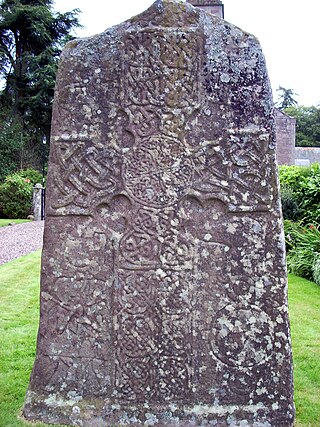
The Glamis Manse Stone, also known as Glamis 2, is a Class II Pictish stone at the village of Glamis, Angus, Scotland. Dating from the 9th century, it is located outside the Manse, close to the parish church. It is inscribed on one side with a Celtic cross and on the other with a variety of Pictish symbols. It is a scheduled monument.
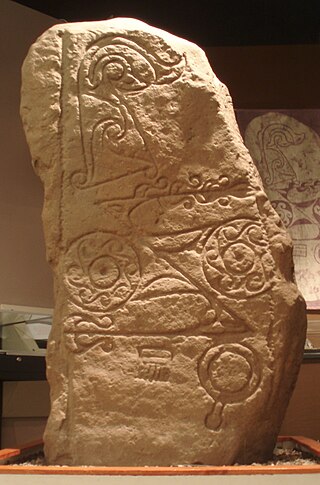
The Dunnichen Stone is a class I Pictish symbol stone that was discovered in 1811 at Dunnichen, Angus. It probably dates to the 7th century AD.

The Monifieth Sculptured Stones are a series of five class II and III standing Pictish stones from the early Medieval period found in or around St Regulus' church in Monifieth, Angus, Scotland. Uncovered during the demolition of a pre-Reformation church and its kirkyard wall in the 19th and 20th centuries, the stones are now housed in the collection of the Museum of Scotland.

The Whitecleuch Chain is a large Pictish silver chain that was found in Whitecleuch, Lanarkshire, Scotland in 1869. A high status piece, it is likely to have been worn as a choker neck ornament for ceremonial purposes. It dates from around 400 to 800 AD.

The Aberlemno Sculptured Stones are a series of five Class I and II Early Medieval standing stones found in and around the village of Aberlemno, Angus, Scotland.

The Woodwrae Stone is a Class II Pictish Stone that was found in 1819 when the foundations of the old castle at Woodwrae, Angus, Scotland were cleared. It had been reused as a floor slab in the kitchen of the castle. Following its removal from the castle, it was donated to the collection of Sir Walter Scott at Abbotsford House. It is now on display at the Museum of Scotland in Edinburgh.

St Orland's Stone is a Class II Pictish Cross-Slab at Cossans, near Kirriemuir and Forfar, Angus, Scotland

The Hunter's Hill Stone, otherwise known as the Glamis 1 Stone, is a Class II Pictish standing stone at Hunter's Hill to the south east of Glamis village, Angus, Scotland.
Inchyra is a hamlet in the Carse of Gowrie in Scotland. It lies on the northern bank of the River Tay near Perth and is notable particularly for a number of archaeological finds made in the immediate vicinity.
The crescent is a Pictish symbol of unknown meaning, that is generally found in combination with an overlaid V-rod on Class I and Class II Pictish stones and infrequently without. The symbol is found in various combinations with other symbols, notably with the double disc and z-rod. The crescent with V-rod is the most frequent symbol, roughly 1 in 5, while the next most frequent symbols, the double-disc and Z-rod and Pictish beast, are half this at roughly 1 in 10.
The mirror and comb are Pictish symbols of uncertain function, found on Class I and Class II Pictish stones. The mirror, or mirror and comb, do not belong to the body of main Pictish symbols, but are used as modifiers of a symbol pair. The mirror can occur on its own, or with the comb, although the comb never occurs on its own. The mirror, or mirror and comb, occur either below the symbol pair, or beside the lower symbol.

Norrie's Law hoard is a sixth century silver hoard discovered in 1819 at a small mound in Largo, Fife, Scotland. Found by an unknown person or persons, most of the hoard was illegally sold or given away. Remaining items of the hoard were found later at the mound, and were turned over to the landowner, General Philip Durham. The surviving 170-piece hoard now is in the National Museum of Scotland. The treasure consists mostly of hacksilver and includes four complete silver pieces.

The Dyce stones are a collection of Pictish and Early Medieval sculptured stones that are housed in a shelter in the ruined St Fergus's Chapel, Dyce, Aberdeen, Scotland. There are two larger stones, known as Dyce I and Dyce II, that bear idiomatically Pictish symbols, as well as several smaller sculptured stones.
The triple disc is a Pictish symbol of unknown meaning, that is found on Class I and Class II Pictish stones. The symbol is found in various combinations with other symbols, notably with the crescent and v-rod. The symbol is constructed from a larger central circle flanked with two smaller circles on either side. It is sometimes shown with a "bar" bisecting all three circles.



